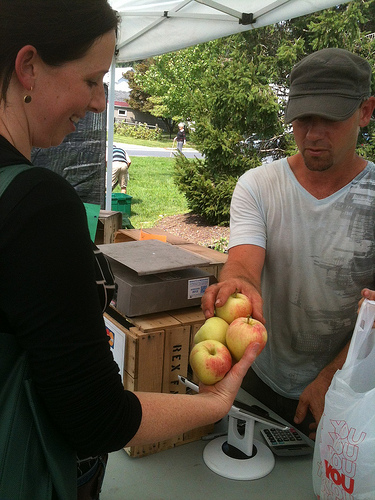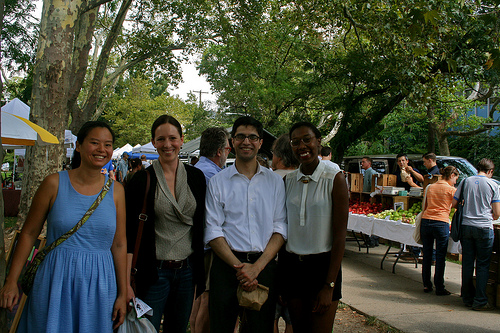In Pennsylvania, Farmers Markets Offer Opportunity to Producers and Communities
Pennsylvania is among the country’s top ten states represented in the USDA’s National Farmers Market Directory. I recently completed a trip through the Fruit Belt to the Lehigh Valley and Philadelphia to see how USDA’s support of farmers market development is impacting communities and helping farmers across the Keystone State.
My first stop was Camp Hill, a small town outside Harrisburg, to visit a new farmers market developed with the assistance of community organizations including Capital Resource and Conservation & Development Area Council (Capital RC&D). Capital RC&D received a USDA Farmers Market Promotion Program grant to help farmers markets improve their consumer outreach and receive EBT and debit payments to expand micro-business opportunities for the area’s local farmers. The market, which just opened in May, is off to a great start with over a dozen vendors selling local bread, meat, dairy and produce from Pennsylvania’s fruit belt.

Buying apples from Troy Lehman of Rex Fruit Farm at the farmers market in Camp Hill, Pennsylvania
A farmers market has been part of Easton, Pennsylvania’s identity since the 18th century. In 2002 however, the market shrank to one vendor. By the next year, with the support of the city government, local farmers, members of the community, and the Greater Easton Development Partnership, the market was revived. Now every Saturday in season, over 40 local farmers and vendors create one of Lehigh Valley’s most vibrant marketplaces in the same town square where the Declaration of Independence was read 236 years ago. With USDA support, the Easton Farmers Market installed the technology needed to accept Supplemental Nutrition Assistance Program (SNAP) benefits and in one year, saw a 20 percent jump in vendor sales. The city also reports that 70 percent of the market’s customers are shopping at downtown business, spending up to an extra $26,000 each week. Easton Mayor Sal Panto highlighted the significant impact of the farmers market to the local community and the comeback of Easton’s downtown as he announced that the farmers market will now be year-round.
Next stop: Greensgrow in the heart of Philadelphia. Transforming a once abandoned city block into a robust urban farm, Greensgrow now boasts a nursery, farm stand, mobile farmers market, and community supported agriculture program with 700 members. With USDA support, Greensgrow established a mobile market to deliver fresh produce to underserved neighborhoods. I followed the Greensgrow mobile market into nearby Camden, New Jersey where I toured the Camden Center for Environmental Transformation, an impressive urban gardening project which brings a whole new meaning to the name “Garden State”.

Food Trust's farmers' market program manager Nicky Uy, Department of Public Health director of policy and planning Giridhar Mallaya and The Food Trust's farmers' market program associate Mukethe Kawinzi joined Walsh (2nd from left) at west Philadelphia’s Clark Park farmers market. (photo by April White, The Food Trust)
My final visit was to the Clark Park Farmers’ Market in West Philadelphia. Here, The Food Trust operates a lively and diverse market which, with USDA and Philadelphia Department of Public Health support, has significantly expanded SNAP transactions. Clark Park and The Food Trust, which operates 26 markets in Philadelphia, both play a critical role in the city’s initiative to expand access to healthy food while also expanding economic opportunities for area farmers.
I used the Know Your Farmer, Know Your Food Compass map to plot my trip. The farmers, community leaders, business owners, and city officials I visited with at each one of these stops clearly illustrated the impact farmers markets are having on small towns, big cities, and the farming communities that surround them.
